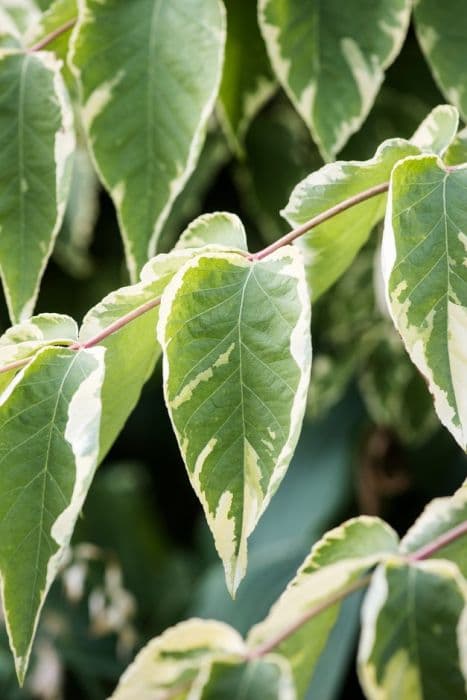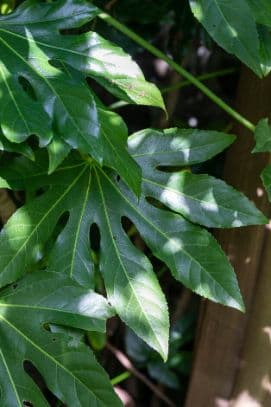Rice-paper Plant Tetrapanax papyrifer 'Rex'

ABOUT
The Rice paper plant, commonly known as the Tetrapanax papyrifer 'Rex', is characterized by its large, striking leaves which give it a tropical appearance. Each leaf is deeply lobed, resembling an outstretched hand with long fingers, and has a lush green color that can transform any space into a verdant oasis. The surface of the leaves is somewhat rough to the touch, similar to fine sandpaper, and they are supported by sturdy stems that give the plant an impressive and robust structure. Although the overall size of the plant is not mentioned, we can note that the leaves themselves are quite large, contributing significantly to the plant's visual impact. Additionally, the Rice paper plant occasionally produces small flowers that are grouped in large, rounded clusters. These flowers are typically less conspicuous than the dramatic foliage, which remains the plant's primary ornamental feature. Overall, the Rice paper plant 'Rex' is appreciated for its bold leaves which create a dramatic and exotic aesthetic in any setting where it is planted.
About this plant
 Names
NamesFamily
Araliaceae.
Synonyms
Rice-paper Plant, Emperor's Rice-paper Plant.
Common names
Fatsia papyrifera, Aralia papyrifera, Panax papyrifer.
 Toxicity
ToxicityTo humans
The plant commonly known as Rice-paper plant is not listed as toxic to humans. However, like with any plant, individual allergies or sensitivities can occur. If ingested, it is unlikely to cause serious harm, but it is generally not intended for consumption. If symptoms do appear after ingestion, it is advisable to consult a medical professional.
To pets
The Rice-paper plant is not specifically documented as toxic to pets such as cats and dogs. That said, ingestion of non-food plants by pets can sometimes lead to gastrointestinal upset or allergic reactions. If a pet ingests this plant and shows adverse symptoms, it is recommended to consult with a veterinarian. Keep in mind that precaution is always wise, as different animals may react differently to various plants.
 Characteristics
CharacteristicsLife cycle
Perennials
Foliage type
Evergreen
Color of leaves
Green
Height
10 feet (3 meters)
Spread
6 feet (1.8 meters)
Plant type
Shrub
Hardiness zones
8
Native area
Taiwan
Benefits
 General Benefits
General Benefits- Ornamental Appeal: Exhibits large, dramatic leaves that add a tropical look to gardens.
- Shade Provider: Creates ample shade in garden areas due to its broad foliage.
- Privacy Screen: Can be used as a natural screen due to its dense growth habit.
- Low Maintenance: Requires minimal care once established, making it a convenient choice for gardeners.
- Cold Hardy: Can withstand temperatures lower than many tropical plants, giving it a broader growing range.
- Drought Tolerance: Once established, it is quite drought-resistant and can survive with less water.
- Fast Growth: Has a rapid growth rate, allowing for quick establishment and impact in landscapes.
- Wildlife Attraction: Attracts birds and pollinators, which enhances biodiversity.
 Medical Properties
Medical PropertiesThis plant is not used for medical purposes.
 Air-purifying Qualities
Air-purifying QualitiesThis plant is not specifically known for air purifying qualities.
 Other Uses
Other Uses- Tetrapanax papyrifer 'Rex', commonly known as Rice-paper Plant, can be used as a natural insulator due to its thick and spongy stem tissues, providing insulation in traditional and eco-friendly construction.
- The large leaves of the Rice-paper Plant are sometimes used as natural wraps for food, imparting a subtle flavor and unique presentation in culinary dishes.
- Fiber from the Rice-paper Plant's stem can be used to manufacture specialty papers, including artistic paper for calligraphy and watercolor paintings.
- Gardeners may use the Rice-paper Plant's leaves as templates for cement garden stepping stones due to their size and shape, creating decorative patterns.
- In craft projects, the pith of the Rice-paper Plant can be carved and pressed into decorative objects or lampshades, utilizing its translucent quality when dried.
- The large, dramatic leaves of the Rice-paper Plant can be used in floral arrangements or as part of set design in theatres for a tropical or exotic look.
- Dried segments of the Rice-paper Plant's stem can be used as lightweight, biodegradable pots for seed starting, reducing the use of plastic in gardening.
- The Rice-paper Plant's unusual texture and growth pattern can be employed in landscape architecture as a living sculpture or focal point in gardens and public spaces.
- Leaves of the Rice-paper Plant can be used in printmaking or as stencils due to their size and the interesting vein patterns they imprint.
- As a natural barrier, the fast-growing Rice-paper Plant can be cultivated to create privacy screens or windbreaks in residential and commercial landscapes.
Interesting Facts
 Feng Shui
Feng ShuiThe Rice-paper plant is not used in Feng Shui practice.
 Zodiac Sign Compitability
Zodiac Sign CompitabilityThe Rice-paper plant is not used in astrology practice.
 Plant Symbolism
Plant Symbolism- Resilience: The plant is known for its vigorous growth and ability to thrive in various conditions, symbolizing the ability to persevere and adapt.
- Wealth and Prosperity: In some cultures, the large leaves are reminiscent of hands catching fortune, representing an abundance of wealth and success.
- Protection: Due to its lush foliage, the Rice-paper Plant can symbolize shelter and protection, as it provides a natural barrier in the garden.
- Endurance: Its persistent nature and the ability to regrow quickly after being cut back is symbolic of endurance and the capacity to recover from life's challenges.
- Renewal: The plant’s ability to produce new shoots from its roots can symbolize new beginnings and the continuous cycle of life and growth.
 Water
WaterThe Rice Paper Plant prefers consistently moist soil, so you should water it deeply whenever the top inch of soil feels dry to the touch. This may roughly translate to watering once a week, but this frequency can vary depending on factors like temperature and humidity. During the growing season in spring and summer, you might find the need to water the plant more frequently. Ensure you provide enough water to saturate the soil thoroughly, which could be up to 1-2 gallons depending on the size of the plant and pot. Reduce the frequency of watering in the winter months when the plant's growth slows down, but don't let the soil dry out completely.
 Light
LightThe Rice Paper Plant thrives best in partial to full sunlight, with a preference for bright, indirect light. It should be placed in a spot where it can get at least a few hours of sunshine each day, such as an east or west-facing window. Avoid intense, direct afternoon sun, as it could scorch the leaves. If grown outside, a dappled shade area would be ideal to provide protection from the harsh midday sun.
 Temperature
TemperatureThe Rice Paper Plant is hardy in USDA zones 7-10, tolerating temperatures down to about 20°F for short periods. The ideal temperature range for this plant is between 65°F and 75°F. During the summer, make sure to protect the plant from extreme heat by providing partial shade, as temperatures above 90°F can stress the plant.
 Pruning
PruningPruning the Rice Paper Plant is primarily done for maintenance and shaping purposes. Trim away any dead or damaged leaves to encourage healthy growth and improve air circulation. Pruning is best carried out in the spring or early summer before new growth begins. Typically, this plant does not require heavy pruning, so only prune it lightly when needed to remove unwanted growth.
 Cleaning
CleaningAs needed
 Soil
SoilThe Rice Paper Plant prefers a rich, well-draining soil mix with an acidic to neutral pH of 6.0 to 7.0. A blend that includes compost, peat moss or coconut coir, perlite, and a small amount of sand can provide the right structure and fertility for optimal growth.
 Repotting
RepottingThe Rice Paper Plant should be repotted every 2 to 3 years to replenish the soil and accommodate its growth. Repotting is best done in spring or early summer before the plant enters its rapid growth phase.
 Humidity & Misting
Humidity & MistingThe Rice Paper Plant thrives in moderate to high humidity conditions, around 40-60%. It benefits from frequent misting or placement in a naturally humid environment like a bathroom if grown indoors.
 Suitable locations
Suitable locationsIndoor
Provide bright, indirect light and keep the soil moist for Rice Paper Plant.
Outdoor
Rice Paper Plant needs partial shade, shelter from wind, and moist soil.
Hardiness zone
8-11 USDA
 Life cycle
Life cycleThe life of the Rice-paper plant (Tetrapanax papyrifer 'Rex') begins with seed germination, where the seed requires warm, moist conditions to sprout, a process that can take several weeks. Once the seedling emerges, it enters the vegetative stage, growing in height and producing its characteristic large, lobed leaves; during this period, it can be sensitive to cold temperatures. As the plant matures, it develops a woody stem and becomes more robust, often reaching several meters in height. The reproductive phase occurs when the plant flowers, typically producing small, white blooms in large, terminal panicles during the late fall or winter months. After pollination, the flowers develop into small, black drupes which contain seeds that can be dispersed to start new plants. Over many years, the Rice-paper plant can also spread vegetatively through underground rhizomes, creating a clonal thicket.
 Propogation
PropogationPropogation time
Spring-Early Summer
Propogation: The Rice Paper Plant, commonly known as Tetrapanax papyrifer 'Rex', can be easily propagated by root cuttings. The ideal time for this method is during the plant's dormancy in late winter or early spring. A section of the root, usually 2 to 4 inches long (5 to 10 centimeters), is cut from a healthy plant and planted horizontally in a moist potting mix. Ensuring that the mix is well-drained yet consistently moist is crucial for the development of new shoots. Once the new shoots appear and establish a sufficient root system, they can be potted up individually and eventually moved to a permanent location in the garden. This method is not only the most popular due to its simplicity but also because it maintains the clonal integrity of the 'Rex' cultivar, ensuring that the new plants will have the same desirable characteristics as the parent.









